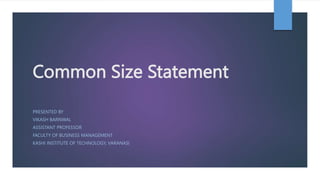
Common Size Statement.pptx
- 1. Common Size Statement PRESENTED BY VIKASH BARNWAL ASSISTANT PROFESSOR FACULTY OF BUSINESS MANAGEMENT KASHI INSTITUTE OF TECHNOLOGY, VARANASI
- 2. Introduction A Vertical Analysis of Financial Statements of a company, in which the amount of individual items of a Balance Sheet of Statement of Profit & Loss are written, is known as a Common Size Financial Statement. The amounts written are then converted into percentage by taking a common base; which is, Revenue from Operations or Net Sales in case of Statement of Profit & Loss and Total Assets or Total Equity and Liabilities in case of a Balance Sheet. The percentages calculated by taking the respective common bases are then compared with the corresponding percentages of other periods, through which meaningful conclusions can be drawn. A Common-size Statement can be prepared for inter-firm and intra-firm comparisons or a Balance Sheet and Income Statement.
- 3. Common-size Statements are accounting statements expressed in percentage of some base rather than rupees.– Kohler A statement that shows the percentage relation of each asset/liability to the total assets/total of equity and liabilities, is known as a Common-size Balance Sheet.
- 4. Objectives of Common Size Balance Sheet Different objectives of a Common-size Balance Sheet are as follows: 1. The basic objective of a Common-size Balance Sheet is to analyse the changes in the individual items of a Balance Sheet. 2. It is also prepared to see the trends of different items of assets, equity and liabilities of a Balance Sheet. 3. Lastly, it is prepared for the assessment of the financial soundness of the organisation and to understand its financial strategy.
- 5. Preparation of Common Size Balance Sheet A Common-size Balance Sheet has the following six columns: 1. First Column: In the first column, the items of the Balance Sheet are written. 2. Second Column: In the second column, Note No. given against the line item is written. 3. Third Column: In the third column, the amounts of different items; i.e., assets, equity, and liabilities of the previous year are written. 4. Fourth Column: In the fourth column, the amounts of different items; i.e., assets, equity, and liabilities of the current year are written. 5. Fifth Column: In the fifth column, the percentage relation of the different items of the previous year’s Balance Sheet to the Total of Equity and Liabilities/Total Assets are written. Here, the Total of Equity and Liabilities/Total Assets are taken as 100. 6. Sixth Column: In the last column, the percentage relation of the different items of the current year’s Balance Sheet to the Total of Equity and Liabilities/Total Assets are written. Here, the Total of Equity and Liabilities/Total Assets are taken as 100.
- 7. From the following Balance Sheet of Shreya Ltd. as at 31st March 2020, prepare a Common- size Balance Sheet:
